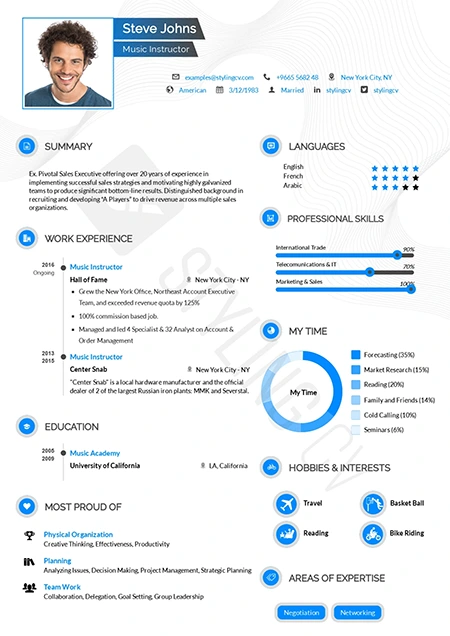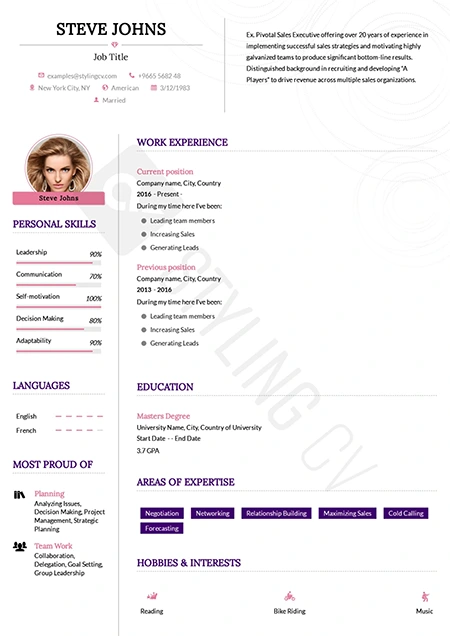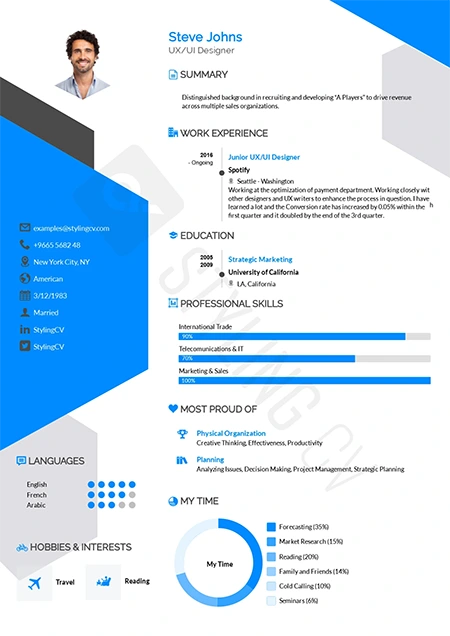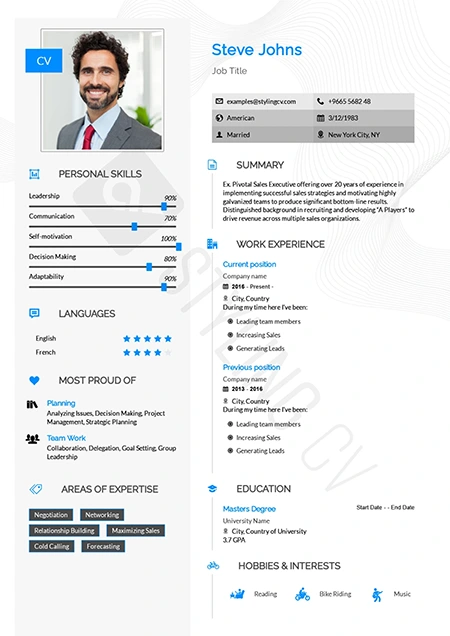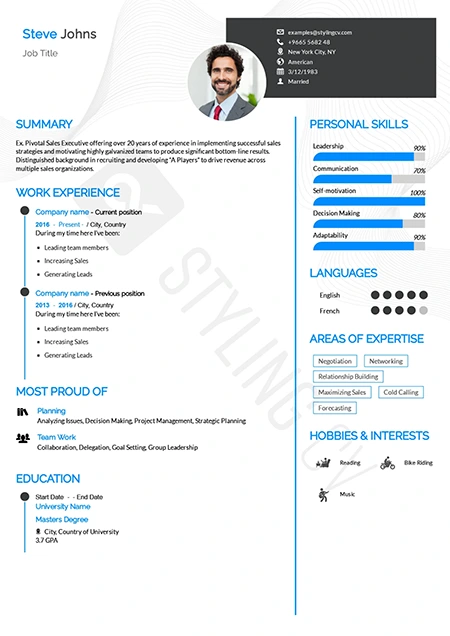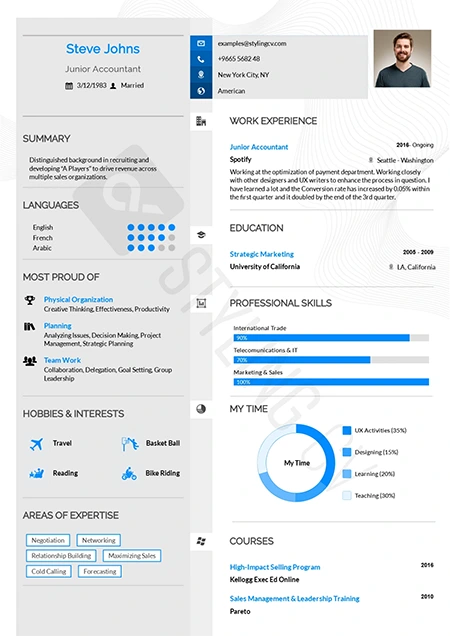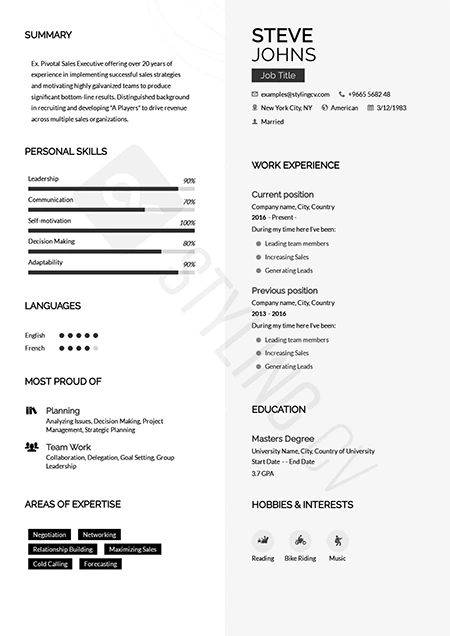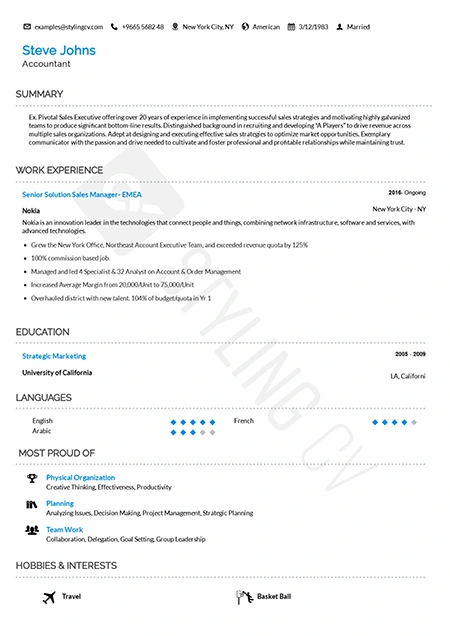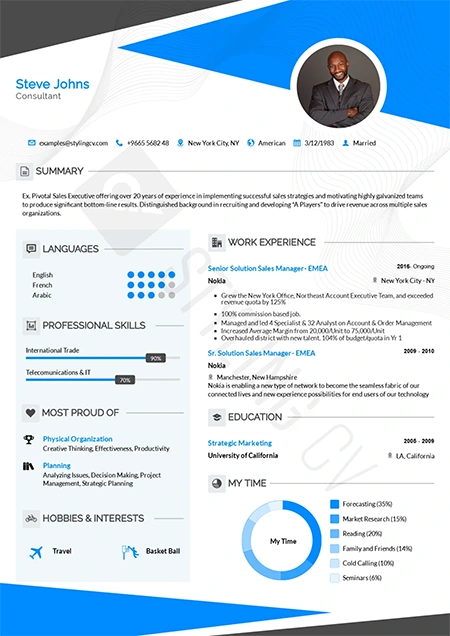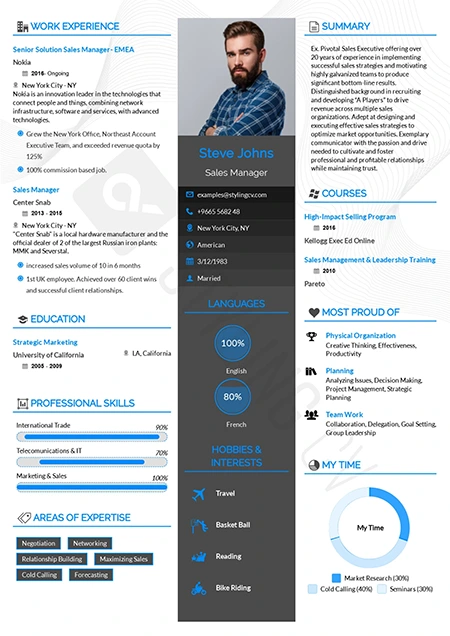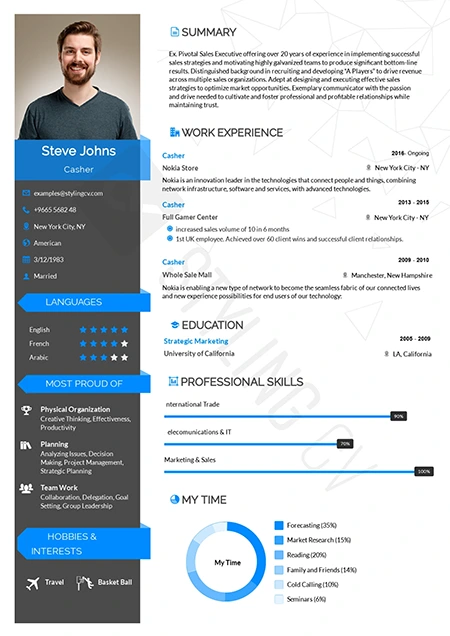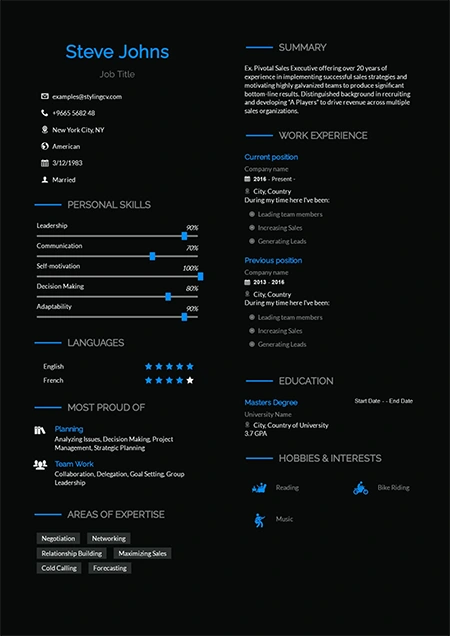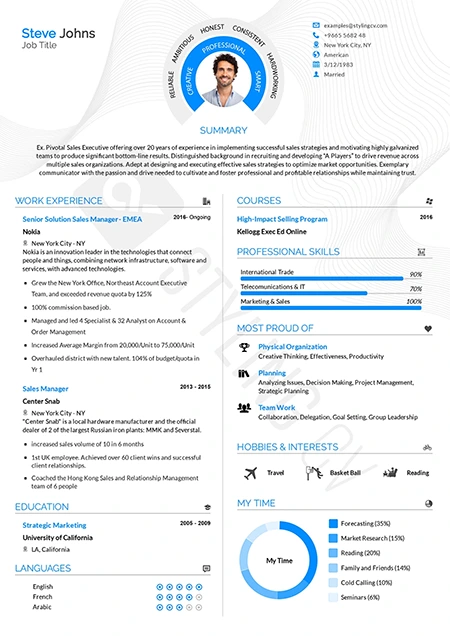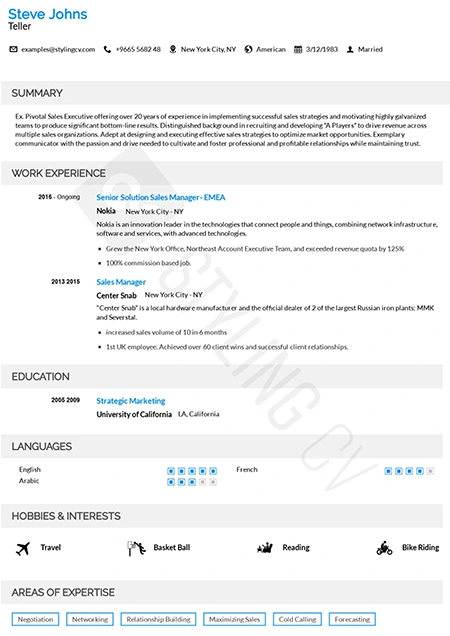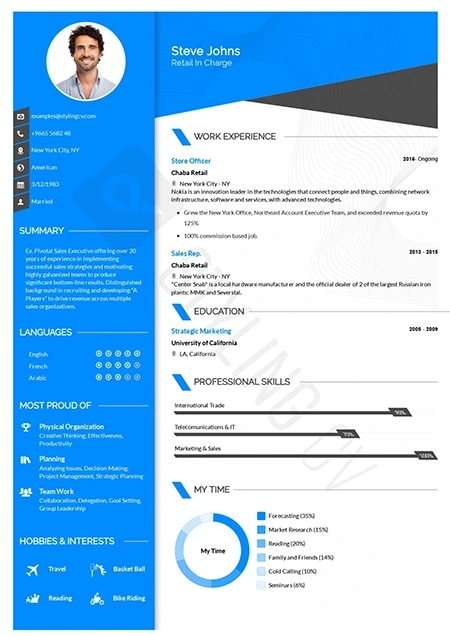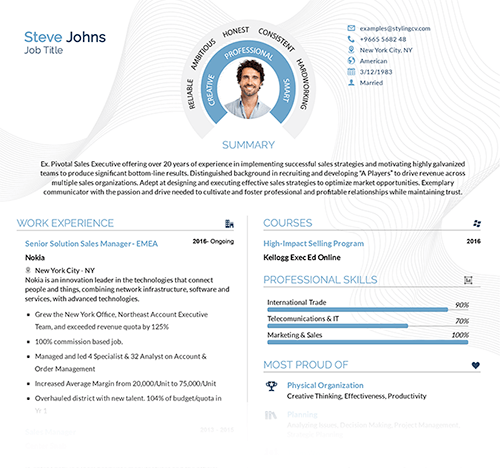nous vous proposons 33+ modèles de CV
Décortiquer le modèle de CV idéal : Intégrer les antécédents professionnels, l'expérience professionnelle, etc.
La rédaction d'un curriculum vitae (CV) efficace peut s'avérer difficile, surtout si vous ne savez pas exactement ce qu'il doit contenir. Le bon modèle de CV peut être la clé qui vous permettra non seulement de mettre en valeur vos antécédents professionnels et votre expérience, mais aussi de vous démarquer des autres candidats. Dans ce guide complet, nous examinons la structure d'un CV efficace, les nuances de sa rédaction et le rôle d'une lettre de motivation pour compléter votre CV.
Les principes fondamentaux d'un modèle de CV
Un curriculum vitae, qui signifie "cours de la vie" en latin, est un document détaillé qui présente votre parcours professionnel et universitaire. Contrairement à un curriculum vitae, qui est généralement concis et adapté à un emploi spécifique, un CV est plus complet et comprend des publications, des présentations et d'autres détails pertinents.
Un modèle de CV idéal contient essentiellement plusieurs sections clés :
- Informations sur le contact: Il s'agit de votre nom complet, de votre titre professionnel, de votre adresse électronique, de votre numéro de téléphone et, éventuellement, de votre profil LinkedIn ou de votre site web personnel.
- Profil personnel: Il s'agit d'une brève présentation de haut niveau de votre parcours, de vos compétences et de vos objectifs de carrière.
- Histoire du travail: Vous détaillerez ici votre parcours professionnel, en précisant vos rôles, vos responsabilités, vos principales réalisations et les entreprises ou organisations pour lesquelles vous avez travaillé.
- L'éducation: Cette section énumère vos diplômes, y compris les institutions que vous avez fréquentées, les diplômes que vous avez obtenus et les dates de vos études.
- Compétences: Il est essentiel de mettre en évidence les compétences, tant matérielles que matérielles, que vous possédez et qui sont pertinentes pour l'emploi auquel vous postulez.
- Certifications et réalisations: Mentionnez toute certification, tout prix ou toute reconnaissance supplémentaire susceptible de renforcer votre profil.
- Références: Elles peuvent être professionnelles ou académiques et doivent être fournies avec leur accord.
Importance des antécédents professionnels et de l'expérience
Les antécédents professionnels et l'expérience professionnelle sont des piliers essentiels de la rédaction d'un CV. Les employeurs accordent souvent une grande importance à ces rubriques, car elles donnent un aperçu de votre potentiel en tant qu'employé. Vos antécédents professionnels doivent être détaillés par ordre chronologique, en commençant par le poste le plus récent. Pour chaque fonction, précisez l'intitulé du poste, l'employeur, les dates d'emploi, ainsi que vos principales responsabilités et réalisations.
Lorsque vous énumérez votre expérience professionnelle, il est essentiel de vous concentrer sur ce que vous avez accompli au cours de votre mandat et sur les compétences que vous avez développées ou perfectionnées. Évitez les déclarations générales et faites en sorte que vos réalisations soient mesurables dans la mesure du possible, en démontrant votre valeur par des exemples concrets.
Juxtaposition de modèles de CV et de curriculum vitae
Bien que les termes "CV" et "curriculum vitae" soient souvent utilisés de manière interchangeable, ils diffèrent en termes de contenu, de longueur et d'objectif. Un modèle de CV est généralement plus court et plus concis, et se concentre principalement sur l'expérience et les compétences pertinentes adaptées à une demande d'emploi spécifique. En revanche, un modèle de CV offre une vue d'ensemble plus détaillée de votre vie professionnelle et universitaire, ce qui convient parfaitement aux postes dans le domaine de l'enseignement, de la recherche ou à ceux qui nécessitent des informations complètes sur la carrière.
Le pouvoir d'une lettre de motivation convaincante
Une lettre de motivation ne doit jamais être une réflexion après coup. Au contraire, elle doit servir d'introduction personnalisée, de plate-forme où vous pouvez expliquer pourquoi vous êtes le candidat idéal pour le poste. Elle vous permet d'expliquer avec vos propres mots comment vos compétences, vos expériences et vos réalisations correspondent aux besoins de l'entreprise. N'oubliez pas que la lettre de motivation n'est pas une répétition de votre CV ; c'est l'occasion de raconter une histoire, de mettre en valeur votre personnalité et d'établir un lien avec le responsable du recrutement.
Dernières réflexions sur la rédaction d'un CV
Lorsque vous rédigez un CV, il est essentiel de l'adapter au poste pour lequel vous postulez. Prenez le temps de vous renseigner sur l'entreprise, de comprendre le poste et d'aligner votre expérience, vos compétences et vos réalisations en conséquence. Votre CV doit être concis, clair et professionnel, en évitant le jargon inutile et les phrases à rallonge. Privilégiez la qualité à la quantité, en veillant à ce que chaque mot ait de la valeur et soit pertinent pour la candidature.
Formatage et présentation
L'aspect visuel de votre CV peut avoir autant d'influence que son contenu. À l'ère du numérique, un CV bien formaté et facile à lire peut faire toute la différence. La mise en page doit être claire et structurée, avec beaucoup d'espace blanc et des sections clairement définies. Utilisez une police de caractères professionnelle et veillez à la cohérence de votre document. Les puces peuvent faciliter la lecture, et des touches de couleur subtiles peuvent faire ressortir votre CV sans l'alourdir.
Coup d'œil sur les CV numériques
Le monde des affaires adoptant de plus en plus les solutions numériques, les CV numériques deviennent de plus en plus courants. Ils offrent une expérience plus interactive et vous permettent d'intégrer des éléments tels que des liens vers des portfolios, des présentations, des publications ou même des introductions vidéo. Veillez à ce que votre CV soit compatible avec les formats papier et numérique afin de répondre aux différentes préférences des employeurs.
Relecture de votre CV
La relecture est une étape cruciale, mais souvent négligée, de la rédaction d'un CV. Une seule coquille ou erreur grammaticale peut nuire à votre professionnalisme et à votre crédibilité. Utilisez des outils de vérification orthographique, mais ne vous y fiez pas uniquement. Lisez votre CV à voix haute, faites-le relire par un pair ou envisagez même de faire appel à des services de relecture professionnels. Cette diligence permet de s'assurer que votre CV est soigné et exempt d'erreurs.
Principaux enseignements
Un modèle de CV complet et bien structuré, comprenant des sections clés telles que l'historique et l'expérience professionnelle, peut être un outil puissant dans votre recherche d'emploi. Associé à une lettre de motivation convaincante, il vous présente comme un candidat complet et soucieux du détail. N'oubliez pas que votre CV est plus qu'une liste de vos expériences professionnelles ; c'est une représentation de votre dévouement, de vos compétences et de votre potentiel.
Par essence, la rédaction d'un CV est un exercice de personal branding. Chaque élément doit fonctionner harmonieusement pour projeter la meilleure version de votre personnalité professionnelle. Que vous soyez un professionnel chevronné ou que vous débutiez votre carrière, investir du temps et des efforts dans votre CV peut vous ouvrir les portes d'opportunités passionnantes. Exploitez la puissance du modèle de CV idéal et faites en sorte que votre candidature se distingue des autres.
Attrapez votre modèle maintenant !
Commencez par nos 100s de widgets et d'options de couleurs pour commencer votre CV
 Sélectionnez
Sélectionnez Un design minimal pour les enseignants et les éducateurs. Des informations graphiques claires qui mettent en valeur vos compétences avec clarté dans votre CV.
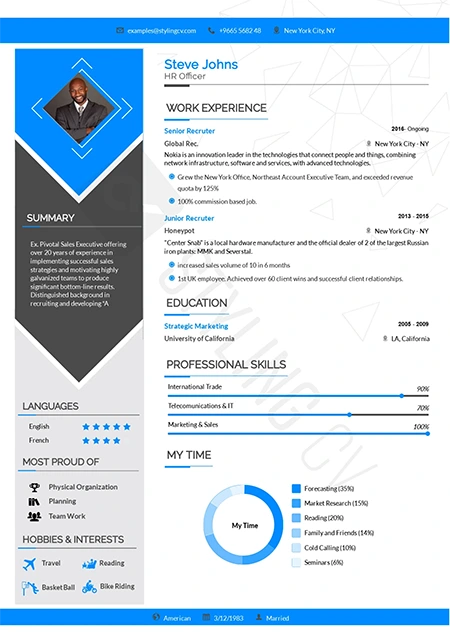 Sélectionnez
Sélectionnez Un CV simple qui présente les capacités et les compétences sous une forme facile et lisible.
 Sélectionnez
Sélectionnez L'en-tête pointu avec ses couleurs vives est un spectacle dominant pour votre CV. Vos compétences ont une place de choix sur la gauche dans ce modèle de CV.
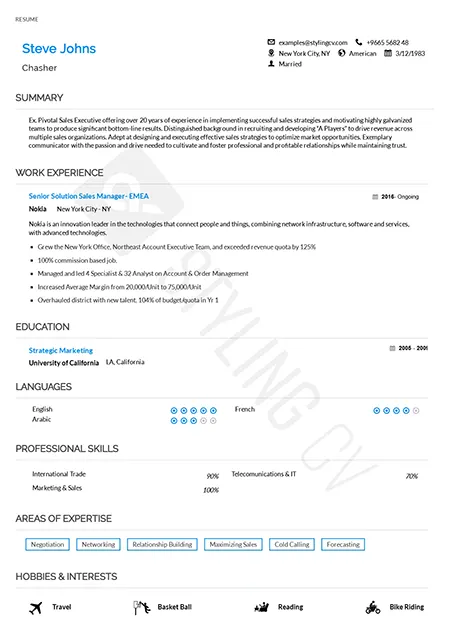 Sélectionnez
Sélectionnez Les langues apprises, les compétences professionnelles et non techniques et les loisirs ont leur place sur la gauche. Alors que vos compétences scolaires et professionnelles se trouvent à droite dans ce modèle de CV.
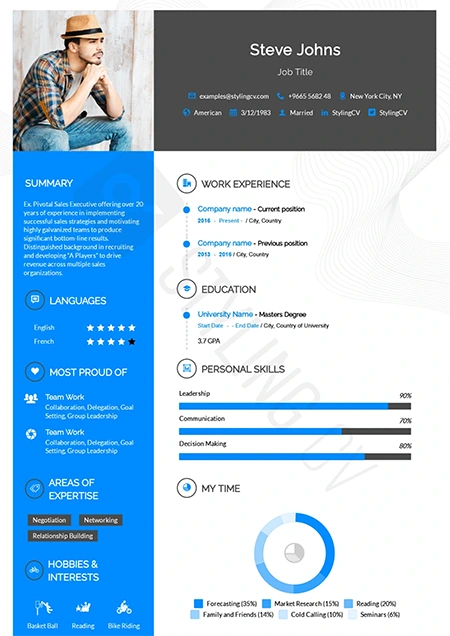 Sélectionnez
Sélectionnez Un modèle de CV lumineux et coloré. Soyez vu par les recruteurs instantanément avec une liste de couleurs variées.
catics-fr
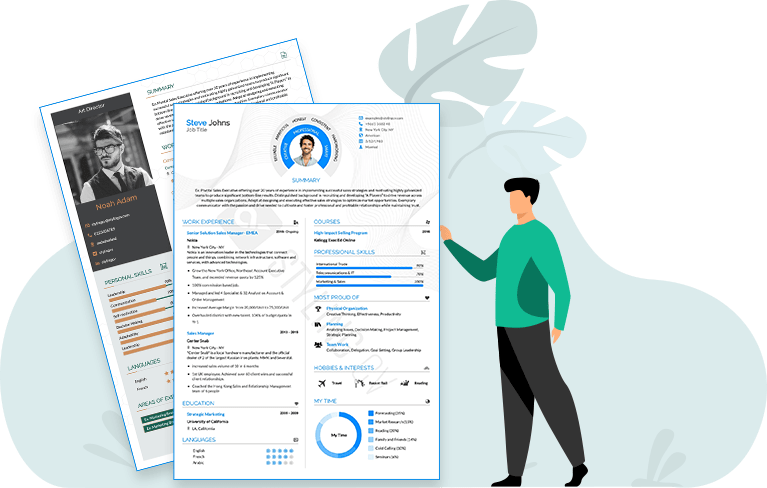
Essayez StylingCV GRATUITEMENT.
C'est facile !
Créer mon CV maintenant
Qu'est-ce qu'un CV ?
Un CV est un bref résumé de votre personne qui montre vos expériences professionnelles et personnelles, vos compétences et votre formation universitaire.
Un CV bien rédigé, accompagné d'une lettre de motivation, peut faire la différence entre obtenir un entretien et ne pas être retenu pour le poste. En savoir plus sur la façon de rédiger un CV.

Comment rédiger un CV pour votre premier emploi ?
La rédaction d'un CV peut vous sembler très intimidante. Après tout, la plupart des exemples de CV que vous voyez sur les sites web sont à 80 % liés à l'expérience professionnelle. Alors, que pouvez-vous inclure dans votre CV si vous n'avez pas d'expérience préalable ?
Eh bien, voici une bonne nouvelle. Si vous postulez pour votre premier emploi, personne ne s'attend à ce que vous ayez une quelconque expérience professionnelle antérieure.
Au contraire, vous devez vous concentrer sur ce que vous avez :
- Éducation
- Projets
- Expérience de bénévolat
- Passe-temps et intérêts.
À propos du guide complet Comment créer un CV sans expérience professionnelle

Que faut-il écrire dans un CV ?
dans un contexte de concurrence intense sur le marché, avec des changements majeurs et fondamentaux, la rédaction d'un CV professionnel est devenue un facteur clé pour réussir à obtenir l'emploi de vos rêves.
Voici quelques éléments essentiels que vous devriez chercher à couvrir dans votre CV :
- Informations de contact
- Résumé du CV et de l'objectif
- Expérience antérieure
- Formation académique
Si vous souhaitez personnaliser votre CV, vous pouvez également inclure les rubriques suivantes :
- Projets
- Expérience de bénévolat
- Passe-temps et intérêts
Pour plus d'informations sur la manière d'intégrer ces rubriques dans un CV, consultez notre article sur le contenu d'un CV.

Comment coordonner le format d'un CV ?
Il existe trois formats de CV typiques :
- Format d'heure inversé
- Format de coordination de l'emploi basé sur les compétences
- La coordination globale combine les deux formats précédents
Dans 99 % des cas, vous voudrez utiliser le format temporel inversé. Le CV se concentre principalement sur vos expériences professionnelles et est rédigé dans l'ordre inverse du temps (c'est-à-dire que les expériences sont classées de la plus récente à la plus ancienne).
À moins que vous ne souhaitiez créer un CV avec un format d'emploi basé sur les compétences, nous vous recommandons de vous en tenir au format horaire inversé.
Si vous souhaitez en savoir plus sur les formats de CV, consultez notre guide comparatif.
Faites toujours en sorte que votre CV corresponde à l'emploi que vous recherchez
Voulez-vous envoyer 50 CV pour obtenir seulement deux entretiens d'embauche ? OU voulez-vous envoyer huit CV et obtenir trois ou quatre entretiens d'embauche ?
Si vous choisissez la deuxième option, c'est facile. Veillez toujours à rédiger votre CV en fonction de l'intitulé du poste auquel vous souhaitez postuler.

Quelle doit être la longueur d'un CV ?
Combien de pages doit contenir un CV ?
La question sur le CV la plus courante au monde : "Quelle longueur doit avoir votre CV ?"
Réponse : une page. Si vous avez beaucoup d'expérience professionnelle (10 ans et plus), il est parfois judicieux de prévoir un maximum de deux pages si tout ce que vous avez mentionné est pertinent pour le poste auquel vous postulez.
Remarque : tous nos modèles sont des CV d'une page. Lorsque vous ajoutez des expériences, une deuxième page est ajoutée automatiquement, de sorte que vous n'aurez aucun problème à respecter la limite d'une page !

Comment rédiger un résumé de CV?
attirer les lecteurs en ajoutant un résumé en haut du CV. Considérez-le comme une introduction à votre CV. En deux ou quatre phrases, vous devez mettre en évidence vos compétences, votre expérience et votre aptitude à occuper l'emploi auquel vous postulez.
Faites briller votre résumé personnel en utilisant cette formule parfaite :
[Titre du poste] avec X + années d'expérience professionnelle en [responsabilité du poste]. En X années, j'ai eu [les deux ou trois] réalisations les plus importantes. Je pense que je suis un bon candidat pour [titre] dans [nom de l'entreprise].
Pour en savoir plus sur la manière de créer un résumé de CV professionnel, consultez notre guide.
En revanche, si vous êtes étudiant ou si vous n'avez pas beaucoup d'expérience professionnelle, lisez comment créer un CV d'étudiant.

Comment rédiger les expériences professionnelles dans un CV
Comment rédiger les expériences professionnelles dans un CV
expériences pratiques sur un CV L'une des choses les plus faciles à apprendre et les plus difficiles à maîtriser.
- Titre du poste
- Le nom de l'entreprise / institution / employeur
- Réalisations ou responsabilités
- Date des travaux
Si vous voulez rédiger une expérience professionnelle exceptionnelle, vous devez vous concentrer sur des réalisations mesurables.
Utilisez cette formule : J'ai résolu le problème (x) en faisant (y) pour obtenir le résultat (z).
Exemple : Négocier un plan avec les fournisseurs pour réduire les dépenses de bureau de 5 000 $ par an.
Montrez vos réalisations à l'aide de chiffres. Ne fournissez pas d'informations sensibles.
a augmenté ses ventes de 20 % en 12 mois.
Cela montre à l'employeur que vous n'êtes pas un candidat quelconque, mais que vous êtes une excellente personne !
Pour en savoir plus sur la façon de rédiger les réalisations dans votre expérience professionnelle (et obtenir le poste), consultez notre article.

Comment énumérer les compétences dans un CV ?
Il suffit de créer une section "Compétences" sur votre modèle de CV, et d'y énumérer vos compétences les plus importantes.
Nous recommandons généralement de rédiger les compétences techniques et personnelles.
Vous ne savez pas quelles compétences inclure dans votre CV ? Consultez les 50 meilleures compétences pour enrichir votre CV.

Comment créer une lettre de motivation pour votre CV ?
Toute candidature à un emploi nécessite une lettre de motivation (en plus de votre CV). Voici quelques conseils pour bien la rédiger :
- Personnalisez votre lettre de motivation pour l'employeur. Plus elle est personnelle, plus vos expériences ont de chances d'être appréciées.
- Identifiez vos expériences générales (expérience professionnelle, titre du poste, etc.) et énumérez les 2 ou 3 réalisations les plus importantes pour démontrer vos compétences.
Si vous voulez vraiment vous démarquer, créez une lettre de motivation qui corresponde à votre modèle de CV. Pour ce faire, vous pouvez utiliser l'une de nos lettres de motivation.

Quel est le meilleur modèle de CV ?
Il n'existe pas de "meilleur modèle de CV" - chaque employé/employeur a ses propres caractéristiques. Nous vous recommandons de faire des recherches sur l'entreprise à laquelle vous postulez
Par exemple, si vous postulez à un emploi dans une banque, vous aurez peut-être besoin d'un modèle de CV plus professionnel. En revanche, si vous souhaitez travailler dans une startup où l'innovation est la plus importante, vous devriez vous en tenir à ce modèle de CV créatif.
Enfin, si vous ne savez toujours pas quel type de modèle convient à l'emploi auquel vous postulez, vous pouvez utiliser l'un des modèles de CV professionnels adaptés à cet emploi.
Ressources CV
Un CV est un bref résumé de vos expériences personnelles et professionnelles, de vos compétences et de votre parcours de formation. Son principal objectif n'est pas seulement de vous montrer sous votre meilleur jour, mais aussi de vous permettre de conserver votre emploi en montrant ce qui vous distingue des autres candidats qui peuvent être en lice pour le même poste !
Vous savez comment faire un CV, mais appliquez-vous les bonnes stratégies ? Nous avons tous entendu parler des "bons" CV et des mauvais. Mais qu'en est-il des bons ? Le meilleur moyen pour les demandeurs d'emploi qui veulent multiplier par deux ou plus leurs chances de trouver du travail ! Consultez ce guide sur la création d'un CV impressionnant qui donne aux recruteurs un élément à cocher sur leur liste lors de l'examen des candidatures.
Comment rédiger un CV pour votre premier emploi ?
La rédaction d'un CV peut vous sembler effrayante. Après tout, la plupart des CV sont constitués à 80 % d'expériences professionnelles et à 20 % de résumés d'autres réalisations, ce qui peut rendre la tâche difficile à ceux qui n'ont pas de réalisations professionnelles ou de formation dans ce domaine !
Je sais que ce n'est pas facile, surtout lorsque l'accent est mis sur la nécessité de mettre le pied dans la porte le plus tôt possible, mais ne vous inquiétez pas, nous avons quelques idées pour commencer à faire en sorte que le vôtre se distingue des autres...
Selon de nombreuses personnes, y compris moi lorsque je débutais dans le secteur et que je postulais moi-même pour des emplois ou des stages, personne ne s'attend à ce que vous ayez UNE expérience professionnelle. L'idée est qu'un employeur accorde des places sur la base de l'ambition uniquement, alors faire quelques recherches à l'avance est vraiment utile !
Si vous cherchez à changer de carrière et que vous n'avez pas d'expérience professionnelle, assurez-vous que votre CV se démarque. Consultez notre guide sur la rédaction d'un CV sans expérience professionnelle.
Que mettre dans un CV ?
- Section de contact
- Objectif ou résumé duCV
- Expérience professionnelle
- Qualifications académiques
- Compétences
- Prix et réalisations
- Langues
- Travail bénévole
- Hobbies
- Activités et projets extrascolaires
Pour plus d'informations sur la manière de placer ces sections sur votre CV, consultez notre article. 10 rubriques essentielles du CV en 2021
Comment formater un CV ?
Parmi les formats de CV les plus efficaces pour 2020, nous avons sélectionné et listé ci-dessous les meilleurs choix pour vous, parmi lesquels vous pouvez sélectionner le meilleur format de CV en fonction de vos exigences respectives et de la demande d'emploi :
- CV chronologique inversé ou à échelle de carrière
- CV basés sur les aptitudes et les compétences
- CV fonctionnels
- Les CV des polyvalents
- CV hybrides ou combinés
Le CV chronologique inversé est le type de CV le plus courant dans les milieux professionnels. Il met l'accent sur votre expérience professionnelle et est rédigé dans l'ordre chronologique inverse, par exemple avec des intervalles de dates qui montrent la progression au sein d'une organisation ou d'un poste au fil du temps.
Si vous souhaitez en savoir plus sur les formats de CV, consultez notre article Les meilleurs formats de CV pour 2020.
Quelle doit être la longueur d'un CV ?
Réponse courte : une page.
Comment rédiger un résumé de CV ?
Un résumé de CV est une brève description de votre expérience, de vos compétences et de vos qualifications. Il s'adresse au responsable des ressources humaines et lui explique pourquoi il devrait vous engager. Si votre résumé professionnel est clair, concis et conforme à leurs exigences, vous susciterez leur intérêt et les encouragerez à poursuivre la lecture de votre CV.
Pour en savoir plus sur la manière de créer un résumé de CV, consultez notre guide 40 exemples de résumés de CV (guide pratique).
Comment faire figurer l'expérience professionnelle sur un CV
Votre expérience professionnelle est l'occasion de dresser la liste de vos réalisations, de vos responsabilités et de vos rôles. Vous pouvez énumérer votre expérience professionnelle comme suit :
- Titre du poste : Pour chaque entrée de poste, indiquez votre titre de travail en première partie.
- Nom de l'entreprise : indiquez le nom de l'entreprise et le lieu où vous avez travaillé dans un rôle spécifique.
- Réalisations/ responsabilités : Dressez la liste de vos réalisations ou de vos responsabilités dans le cadre du poste. Soyez aussi détaillé que possible. Par exemple : "Création d'un nouveau modèle de mot-clé et de titre pour le marketing organique entrant et augmentation de l'engagement du blog de 20% en 3 mois".
- Dates d'embauche.
Comment énumérer les compétences sur un CV ?
Selon la dernière enquête menée par un site web sur les carrières, les gens ont souvent tendance à choisir des compétences bizarres à mettre sur leur CV, qui n'ont pas de rapport particulier avec le poste qu'ils envisagent d'occuper ou le domaine dans lequel ils veulent faire carrière. En conséquence, soit l'employeur jette le CV à la poubelle, soit il l'écarte après un coup d'œil superficiel. Par conséquent, choisir les meilleures compétences professionnelles qui correspondent à n'importe quel choix de carrière semble être une tâche délicate. Pour vous faciliter la tâche et la rendre plus efficace, nous avons dressé une liste de 101 compétences essentielles à faire figurer sur un CV [pour n'importe quel emploi]. Ces compétences professionnelles peuvent être intégrées dans votre CV pour n'importe quel emploi auquel vous postulez.
Comment rédiger une lettre de motivation pour un CV ?
La recherche d'un emploi, ça craint. Parcourir les offres d'emploi en ligne, peaufiner son CV et se préparer à des entretiens épuisants, rien de tout cela n'est amusant. Pour beaucoup, la partie la plus décourageante du processus est la rédaction d'une lettre de motivation. Il existe tellement de conseils contradictoires qu'il est difficile de savoir par où commencer.
Si vous souhaitez en savoir plus sur la manière de rédiger une lettre de motivation efficace, consultez notre guide complet.
